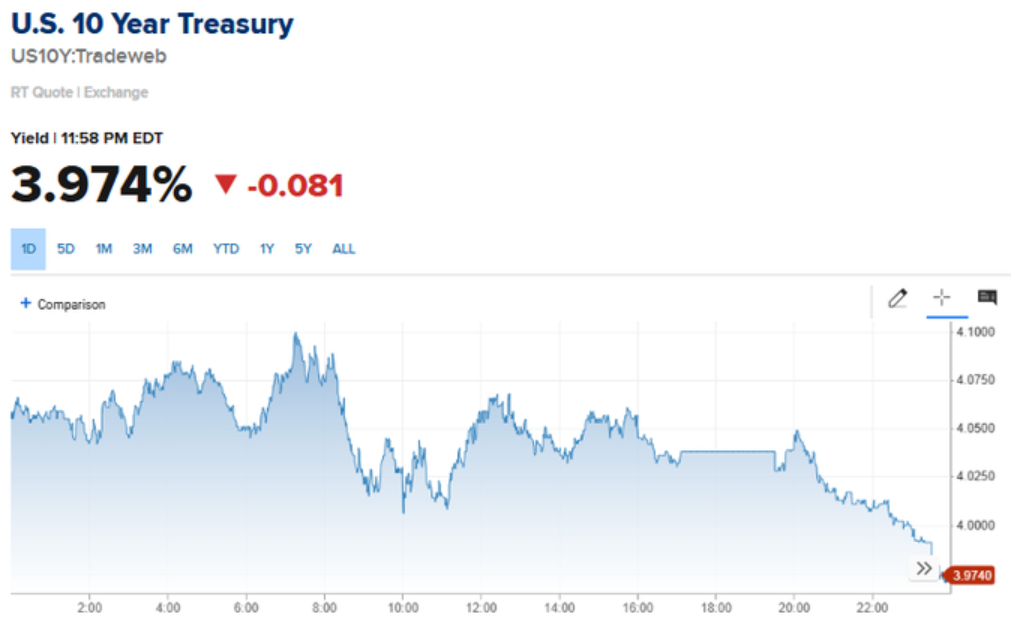The U.S. 10-year Treasury yield has fallen below 4% for the first time since October.
This suggests a potential change in Federal Reserve (Fed) policy and reignites interest in Bitcoin (BTC) and other risk assets.
Treasury Yield and Bitcoin... Preference for Risk Assets?
As financial market aggregator Barchart highlighted, this decline reflects growing economic uncertainty. Specifically, it indicates increasing concerns about a recession and speculation that the Fed may pivot to rate cuts sooner than expected.

The decline in Treasury yields reduces the attractiveness of traditional safe-haven bonds, driving investors to seek higher returns.
Historically, Bitcoin and altcoins have benefited from such changes. Falling real yields increase liquidity and risk appetite. Crypto analyst Dan Gambardello emphasized this connection. He mentioned that lower yields are positive for Bitcoin and align with expectations of a dovish Fed driving liquidity into risk assets.
"Ironically, as yields fall, there's less reason to stay in 'safe' bonds. Ultimately, there's more reason to seek returns in risk assets like BTC and altcoins. This is why risk-seeking investors get excited when 10-year yields start to fall," he said.
Additionally, BitMEX founder and former CEO Arthur Hayes noted that the 2-year Treasury yield has plummeted following new tariffs. He said this strengthens market expectations of an imminent Fed rate cut.
"We need Fed easing. The sharp drop in 2-year Treasury yields after the tariff announcement indicates the market is saying the Fed will soon cut rates and restart quantitative easing to offset economic impacts," Hayes shared on X (Twitter).
Hayes previously predicted that Bitcoin could surge to as high as $250,000 if quantitative easing (QE) is restarted in response to an economic downturn.
Trump Factor, Tariffs, and Market Volatility
Analysts also noted that economic uncertainty from Trump's aggressive tariff strategy is related to the yield decline. Gambardello mentioned that these tariffs triggered a move to safe assets, pushing bond prices up and yields down.
This trend aligns with Trump's broad economic approach of promoting economic growth through dollar weakness and rate cuts. During his first term, he frequently wanted a weaker dollar and rate cuts to boost exports and economic growth. He also pressured the Fed multiple times to cut rates.
Another analyst, Kristoffer Kepin, emphasized that M2 money supply is increasing. This strengthens expectations of increased liquidity entering the market. Such capital inflows could flow into Bitcoin and altcoins as investors seek alternative stores of value amid economic turmoil.
Despite Bitcoin's potential rise, Goldman Sachs recommended gold and the Japanese yen as preferred hedges against U.S. recession risk, citing their historical performance in risk-averse environments.
"The yen provides the best currency hedge for investors if the likelihood of a U.S. recession increases," Bloomberg reported, quoting Kamakshya Trivedi, Goldman Sachs' global head of FX, rates, and emerging markets strategy.
The bank also expressed similar sentiments about gold, upgrading its outlook as investors buy gold. Similarly, a Bank of America (BofA) survey showed that 58% of fund managers prefer gold as a trade war refuge, with only 3% supporting Bitcoin.
Meanwhile, JP Morgan raised the global recession probability to 60%. The multinational bank and financial services company stated that economic shocks from tariffs announced on Liberation Day increased risks.
"If these policies persist, they are likely to drive the U.S. and global economy into a recession this year," wrote Bruce Kasman, global head of economic research, in a late Thursday memo.
However, Kasman acknowledged that while a scenario of U.S. recession causing global chaos is possible, it is less likely than a global recession.
As Treasury yields continue to fall and economic uncertainty grows, the Fed becomes a critical focus for investors seeking signals of policy changes.
If rate cuts and liquidity injections materialize, Bitcoin could see significant gains while traditional assets are reevaluated. However, as experts warn, short-term volatility remains a key risk factor amid these market changes.

According to BeInCrypto data, Bitcoin is currently trading at $82,993, up 1.42% in the last 24 hours.





